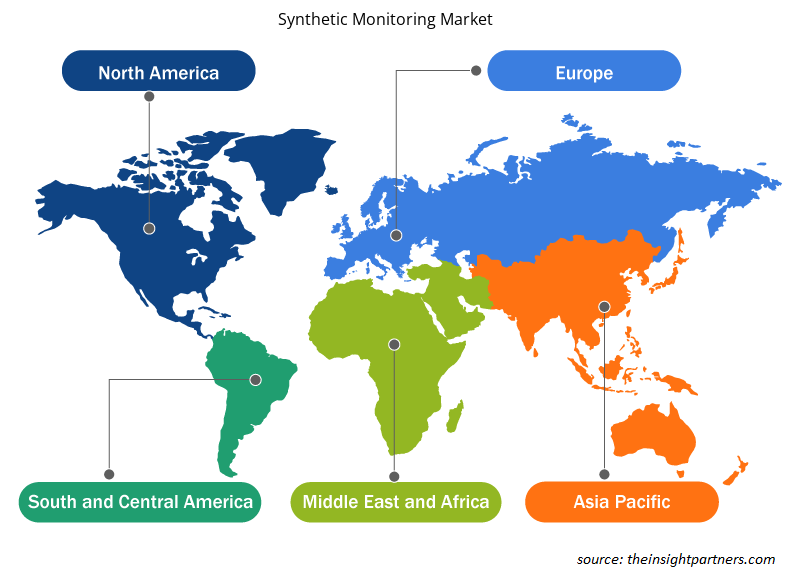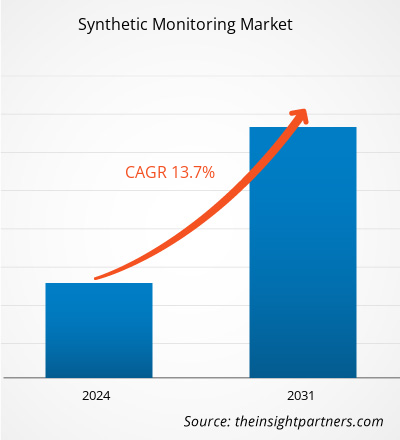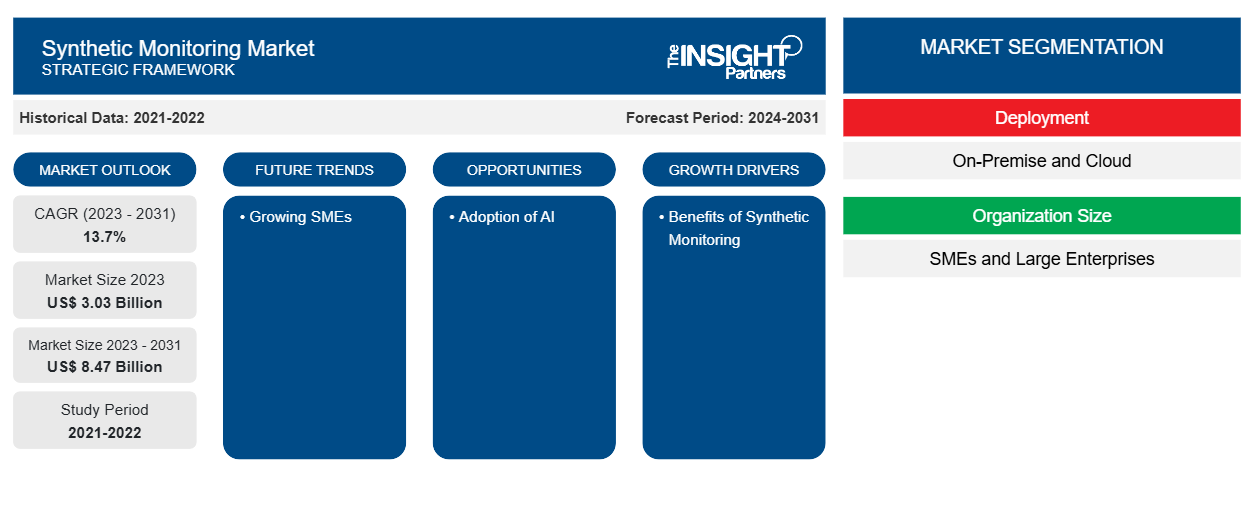预计到 2031 年,综合监控市场规模将从 2023 年的 30.3 亿美元增至 84.7 亿美元。预计 2023-2031 年市场复合年增长率将达到 13.7%。云计算的日益普及和数字化的兴起可能仍是综合监控市场趋势的关键。
综合监测市场分析
政府通过提供财政援助、激励措施和举措来提高中小企业的业务能力,这有助于采用软件解决方案,例如综合监控解决方案。不断增长的云市场是推动综合监控市场发展的主要因素之一,因为云是一种经济高效的解决方案,它导致许多大型企业和中小企业采用基于云的综合监控解决方案,从而进一步推动了综合监控市场的发展。
综合监测市场概况
综合监控是指使用软件模拟用户与系统的交互。然后分析从模拟交易中收集的数据以确定系统的运行方式。例如,综合监控可用于确定网站是否达到所需的页面加载、响应时间和正常运行时间。
定制此报告以满足您的需求
您可以免费定制任何报告,包括本报告的部分内容、国家级分析、Excel 数据包,以及为初创企业和大学提供优惠和折扣
-
获取此报告的关键市场趋势。这个免费样品将包括数据分析,从市场趋势到估计和预测。
综合监测市场驱动因素和机遇
综合监测有利于市场
合成监控解决方案允许最终用户在实际用户与系统交互之前预测系统将如何响应用户请求。合成监控允许最终用户在投入生产之前验证系统是否满足性能和可用性要求。在这方面,合成监控允许主动监控。此外,合成监控对于评估系统对异常或不频繁请求的响应很有用,这些请求可能无法在从真实用户发起的交易收集的数据中捕获。因此,合成监控有助于验证系统性能并在潜在问题影响最终用户体验之前识别它们。合成监控支持主动监控并在性能和可用性问题破坏生产应用程序之前解决它们,从而帮助最终用户提升客户体验。
不断增长的中小企业市场SMEs market
企业使用综合监控工具来监控企业应用程序,并通过模拟多项客户活动提供有关关键业务交易的正常运行时间和整体性能的信息。这些工具使企业能够弥补可能影响整体最终用户体验的性能差距。因此,日益增长的数字化和政府对中小企业的支持促进了中小企业采用软件解决方案来提高其工作流程效率的能力。此外,随着数字化转型趋势提高整体运营效率和最终用户体验,未来将有更多中小企业采用综合监控解决方案。
综合监测市场报告细分分析
有助于得出合成监测市场分析的关键部分是墨水部署、组织规模、监测类型和行业。
- 根据部署方式,市场分为本地部署和云部署。预计云部署将以最高的复合年增长率增长。
- 根据组织规模,市场分为中小型企业和大型企业。预计中小型企业的复合年增长率最高。
- 根据监控类型,市场分为 API 监控、SaaS 应用程序监控、移动应用程序监控和Web 应用程序监控。API 监控部分在 2023 年占据了最大的市场份额。
- 根据行业,市场分为 BFSI、政府、零售、医疗保健、IT 和电信以及其他行业。零售业预计将以最高的复合年增长率增长。
按地区划分的综合监测市场份额分析
综合监测市场报告的地理范围主要分为五个地区:北美、亚太、欧洲、中东和非洲、南美/南美和中美。
亚太地区预计将以最高的复合年增长率增长。该地区云技术的普及推动了该地区市场的增长。该地区不断增长的中小企业推动了该地区对软件解决方案的需求,推动了合成监测技术的使用。印度和中国等新兴经济体的数字化转型导致各种终端用户行业采用合成监测解决方案。
综合监测市场区域洞察
Insight Partners 的分析师已详细解释了预测期内影响合成监测市场的区域趋势和因素。本节还讨论了北美、欧洲、亚太地区、中东和非洲以及南美和中美洲的合成监测市场细分和地理位置。

- 获取综合监测市场的区域特定数据
综合监测市场报告范围
| 报告属性 | 细节 |
|---|---|
| 2023 年的市场规模 | 30.3亿美元 |
| 2031 年市场规模 | 84.7 亿美元 |
| 全球复合年增长率(2023 - 2031) | 13.7% |
| 史料 | 2021-2022 |
| 预测期 | 2024-2031 |
| 涵盖的领域 |
按部署
|
| 覆盖地区和国家 |
北美
|
| 市场领导者和主要公司简介 |
|
综合监控市场参与者密度:了解其对业务动态的影响
合成监测市场正在快速增长,这得益于终端用户需求的不断增长,而这些需求又源于消费者偏好的不断变化、技术进步以及对产品优势的认识不断提高等因素。随着需求的增加,企业正在扩大其产品范围,进行创新以满足消费者的需求,并利用新兴趋势,从而进一步推动市场增长。
市场参与者密度是指在特定市场或行业内运营的企业或公司的分布情况。它表明在给定市场空间中,相对于其规模或总市场价值,有多少竞争对手(市场参与者)存在。
在合成监控市场运营的主要公司有:
- 阿皮卡
- AppDynamics有限责任公司
- 博通公司
- Dynatrace LLC.
- eG Innovations, Inc.
- IBM 公司
免责声明:上面列出的公司没有按照任何特定顺序排列。

- 获取合成监控市场顶级关键参与者概览
综合监测市场新闻和最新发展
合成监测市场通过收集一手和二手研究后的定性和定量数据进行评估,其中包括重要的公司出版物、协会数据和数据库。以下是市场发展情况的列表:
- 2023 年 7 月,谷歌推出了综合监控,这是一项新的主动监控功能,它使用自动化的 Node.js 脚本来模拟用户与应用程序或服务的交互。这使您可以定期从真实用户的角度测试 Web 应用程序、API 和关键业务工作流的可用性、一致性和性能。2023 年 11 月,谷歌宣布全面推出综合监控。此外,随着此次发布,该公司还增加了新的综合监控功能。(来源:谷歌,新闻稿,2023 年)
- 2022 年 3 月,Synthetic API Monitoring 扩展了 AppDynamics Synthetic Monitoring,为 ITOps 和 DevOps 提供支持,帮助最大限度地减少 API 性能和可用性问题对业务成果和用户体验的影响。(来源:AppDynamics,新闻稿,2022 年)
综合监测市场报告覆盖范围和交付成果
“合成监测市场规模和预测(2021-2031)”报告对以下领域进行了详细的市场分析:
- 范围内所有主要细分市场的全球、区域和国家层面的市场规模和预测
- 市场动态,如驱动因素、限制因素和关键机遇
- 未来的主要趋势
- 详细的 PEST/波特五力分析和 SWOT 分析
- 全球和区域市场分析涵盖关键市场趋势、主要参与者、法规和最新市场发展
- 行业格局和竞争分析,涵盖市场集中度、热点图分析、知名参与者和最新发展
- 详细的公司简介
- 历史分析(2 年)、基准年、预测(7 年)及复合年增长率
- PEST和SWOT分析
- 市场规模、价值/数量 - 全球、区域、国家
- 行业和竞争格局
- Excel 数据集
近期报告
客户评价
购买理由
- 明智的决策
- 了解市场动态
- 竞争分析
- 客户洞察
- 市场预测
- 风险规避
- 战略规划
- 投资论证
- 识别新兴市场
- 优化营销策略
- 提升运营效率
- 顺应监管趋势























 获取免费样品 - 综合监测市场
获取免费样品 - 综合监测市场